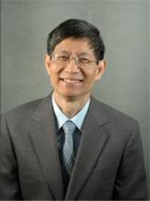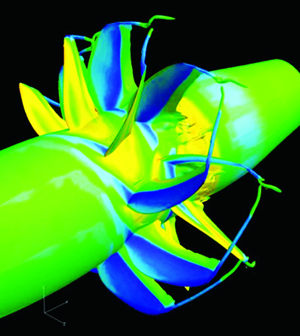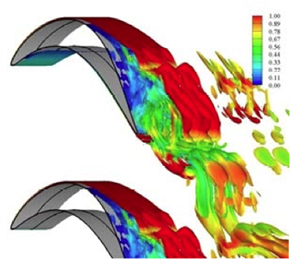Chen leverages Ohio Supercomputer Center resources to refine TURBO
Columbus, Ohio (Dec. 20, 2011) – For most of us, the word “turbomachinery” may conjure up images of superheroes or fast exotic cars, but in reality most people leverage turbomachinery to get things done nearly every day.
 |
| Jen-Ping Chen |
Turbomachinery – pumps, fans, compressors, turbines and other machines that transfer energy between a rotor and a fluid – is especially instrumental in power generation in the aeronautic, automotive, marine, space and industrial sectors. For engine designers to achieve the most efficient propulsion and power systems, they must understand the physics of very complex air-flow fields produced within multiple stages of constantly rotating rotors and stators.
Jen-Ping Chen, Ph.D., an associate professor of mechanical and aerospace engineering at The Ohio State University, is working to improve the computational fluid dynamics (CFD) software that engineers use to simulate and evaluate the operation of turbomachinery. Chen was the chief architect of that type of computer code, appropriately named TURBO, which he developed earlier for NASA.
Chen is leveraging the computational power of the Ohio Supercomputer Center to refine the software as it validates the flow field of engine components, specifically as it applies to high-pressure compressors and low-pressure turbines.
“The world is demanding increasingly cleaner, more efficient and reliable power systems,” noted Ashok Krishnamurthy, interim co-executive director of OSC. “Therefore, it is essential that experts like Dr. Chen find innovative ways to improve the tools the engineers need to accomplish that goal, and we at OSC are proud to be able to provide the computational resources that make that effort successful.”
Each turbomachinery component has unique physical characteristics that present difficulties in design and operation, such as stall in a compressor and cooling in a high-pressure turbine. With a simulation tool that is validated and optimized to run efficiently on a large computer cluster, engine designers will have more physical insight to the complex flow field, which will lead to reduced testing, reduced risk, faster time-to-market and lower costs.
While traditional wind-tunnel testing is often the most straightforward approach, it also comes with high costs and severe constraints on placing the measurement probes, according to Chen. Numerical simulation, using CFD, has provided an alternative for studying such flows at a lower cost and with unconstrained probe placement. Yet, the accuracy of a simulation depends on the accuracy of the mathematical model behind the simulation.
“Our goal is to develop a reliable prediction technology to help improve turbomachinery component design,” said Chen. “The successful combination of CFD simulation and experimentation can greatly supplement the understanding of fundamental fluid behavior of gas turbine systems, thus enhancing the ability of engineers to develop more advanced engine components.”
Chen’s team is investigating three specific areas of current industrial interest: coupled fluid-structure interaction, active flow control and turbine film cooling. Improved numerical simulation will allow engineers to analyze complex flow fields and aeroelastic phenomena, such as flutter, limit-cycle oscillations, forced response, nonsynchronous vibrations and separated-flow vibrations, which arise from fluid-structure interaction.
Application of a newly developed flow control simulation model for vortex-generating jets in low-pressure turbines will help improve engineers’ understanding of how flow control can be used to increase the performance and operability of gas turbine engines. And, finally, simulations can help engineers accurately predict the effectiveness of film cooling on heat transfer in a three-dimensional, unsteady, rotating environment with actual engine geometry.
The Ohio Supercomputer Center (OSC), a member of the Ohio Technology Consortium of the Ohio Board of Regents, addresses the rising computational demands of academic and industrial research communities by providing a robust shared infrastructure and proven expertise in advanced modeling, simulation and analysis. OSC empowers scientists with the vital resources essential to make extraordinary discoveries and innovations, partners with businesses and industry to leverage computational science as a competitive force in the global knowledge economy, and leads efforts to equip the workforce with the key technology skills required to secure 21st century jobs. For more, visit www.osc.edu.
The Ohio State Department of Mechanical and Aerospace Engineering offers bachelor's degrees in mechanical engineering and aeronautical and astronautical engineering, and master's and doctoral degrees in mechanical, nuclear, and aeronautical and astronautical engineering. The mission of the department is the education of professionals in mechanical, aerospace and nuclear engineering, the dissemination of knowledge and technology, and the development of innovative solutions to problems in these fields. For more, visit mae.osu.edu.

